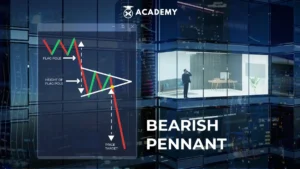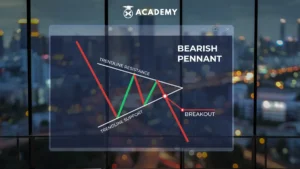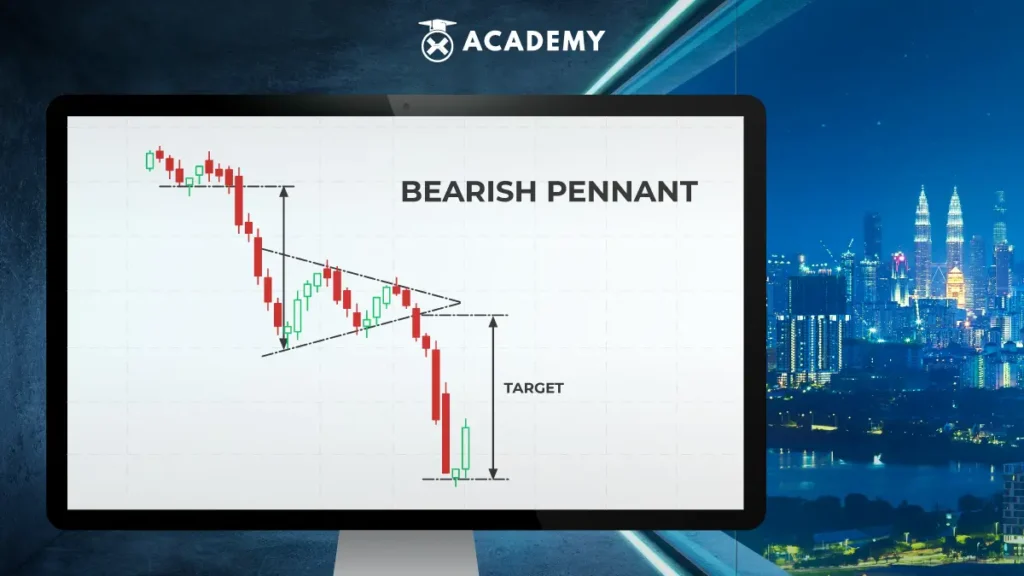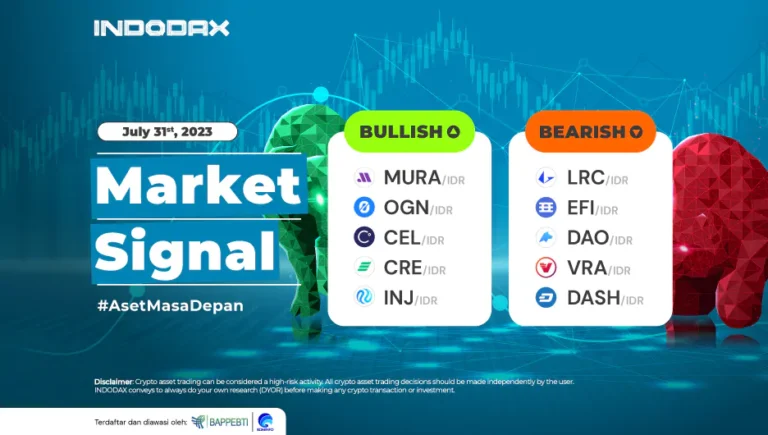In making trading decisions, traders usually use patterns from technical analysis, one of which is a bearish pennant.
The pennant pattern or continuous pattern itself is used as a basis for predicting the next market movement.
P pennant patterns are divided into two types, namely bearish pennant and bullish pennant.
So, to understand more about what a bearish pennant means and how to use it in trading, see the following review.
What is the Pennant Pattern?
A pennant is an advanced pattern created when there is an asset movement or what is known in technical analysis as a flagpole.
A pennant pattern often follows a consolidation period with converging trend lines and a breakout movement in the same direction.
As for literally, this pattern is also referred to as a “banner” pattern or “pennant,” which marks a pattern of price movements that shows an illustration/prediction regarding the possibility of a trend continuation pattern or forwarding the direction of a trend.
The reason behind the mention of the pennant pattern as the pennant pattern is that the pennant is formed due to a strong trend movement, followed by a consolidation of the triangular pattern which forms a pennant-like shape.
It is important to know that this pennant pattern can occur in all existing time frames.
What is a Bearish Pennant?
Meanwhile, a bearish pennant is a type of pennant pattern that forms a downward price trend.
This pattern was born when the price moved to show a strong downtrend, then a correction occurred which was marked by small candlestick patterns and usually narrowed.
The price formation will then form a triangular pattern indicating consolidation.
In short, this pattern will start to form when the flagpole shows a sharp/very strong drop in price, accompanied by a pause, creating a triangle or pennant.
This condition occurs when some sellers make profits or profit-taking.
Then, the rate of decline will continue after a breakout from new sellers entering the market.
This causes the price to be strongly pushed to continue the downtrend.
Bearish pennant has three main characteristics, which are as follows:
1. Flagpole
The place line always starts a pennant pattern with a function as a differentiator from other patterns (such as a symmetrical triangle). The flagpole is what is considered the initial strong movement before the symmetrical triangle is created.
2. Pennant
This triangle pattern is formed when the market consolidates. Its position is between the flagpole and the breakout. Meanwhile, two converging lines will form a triangle, namely the pennant.
3. Breakouts
After the price movement penetrates one side of the pennant, generally, a breakout will be marked by a strong movement in one direction, either up or down.
Factors Influencing the Bearish Pennant
The following factors influence the bearish pennant:
- Make sure this pattern is formed and confirmed by a break at the support level.
- Pay attention to trading volume when there is price consolidation. The reason is that a too-low volume will indicate that the pattern needs to be stronger.
- Also, observe other technical indicators, such as the Relative Strength Index (RSI) or the Moving Average Convergence
- Divergence (MACD), to confirm signals from a bearish pennant.
If there is confirmation from the technical indicators, traders can consider selling/limiting losses.
How to Identify a Bearish Pennant
Bearish pennants can be identified easily when the trading trend tends to decrease.
A simple description of the bearish pennant pattern is as follows:

From the picture above, the components of a bearish pennant are not too different from a bullish pennant, namely flagpoles, pennant, and breakout.
However, different from the bullish pennant, the bearish pennant has a flagpole pointing downwards, indicating a downward trend in trading.
The declining trading trend was followed by a pennant forming a sideways triangle and ended with a downward breakout.
How to Use and Trading Strategies Based on the Bearish Pennant when Trading
In general, traders will use bearish pennants to make decisions and determine profit opportunities by means of stop losses.
Let’s look at the chart below to understand this better:

1. Determine exit and short positions
The area represented by the numbers 1 and 2 in the black circle in the image above indicates a bearish pennant.
Meanwhile, the conditions shown in the box with the number 1 (orange color) are the most suitable positions for traders to sell assets to suppress increasing losses.
On the other hand, a trader can also enter a trade at that point, but by taking a short position.
In the future, the trader can profit if the asset price decreases.
2. Take profits
Profit targets or profits in bearish pennant conditions will be illustrated through the lowest point in trading, as seen in number 3 in the image above.
The lower the asset price, the more profitable the trader will be.
3. Place a stop loss
Traders can put in the box containing the number 2 (in red) when he takes a short position so that the stop loss is in a bearish pennant condition.
This position shows a recovery from the trading trend, in the sense that there will be no breakout in the bearish pennant, while the asset price will rise again.
Advantages and Disadvantages of Using a Bearish Pennant-Based Strategy
Here are some of the advantages and disadvantages of using a strategy based on a bearish pennant, which are as follows:
1. Advantages
- Bearish pennants can help traders make more measurable trading decisions.
- Bearish pennant will also help traders avoid assets in a downtrend phase.
2. Disadvantages
- Occasionally there will be errors in detection and terms of interpretation of the bearish pennant. Therefore, traders must always be careful.
- When using a bearish pennant, traders must consider several other factors affecting price movements, including volatility, fundamental factors, and market risk.
Disclaimer
To trade with this bearish pennant pattern, a trader must correctly understand the formation of this pattern.
Besides that, traders must also be able to apply the correct trading strategy.
This also includes placing a sell order on a break down of price consolidation and setting a stop loss above the peak of the consolidation.
Furthermore, traders will also have a great chance to successfully trade with a bearish pennant.
Especially if he does several things such as thoroughly analyzing the market, combining it with other indicators, consulting with fellow traders/mentors, and practicing and testing.
However, traders must always monitor price movements and ensure that trading strategies align with changing market conditions.
Therefore, a bearish pennant must also be part of a thorough market analysis and be applied measurably in the appropriate market context.
Conclusion
In conclusion, a bearish pennant is a type of continuous or pennant pattern that forms a downward price trend.
This pattern is formed when the price moves to show a strong downtrend, and then a correction occurs, which is marked by small candlestick patterns that tend to narrow.
The price formation will then form a triangular pattern indicating consolidation.
Three main characteristics are possessed by a bearish pennant, namely flagpole, pennant, and breakout.
Meanwhile, some advantages when using this pattern are:
(1) bearish pennant can help traders in making trading decisions in a more measurable and
(2) will help traders avoid assets in a downtrend phase.
Do you understand a bearish pennant and how to use it in trading?
Furthermore, you can also read other interesting articles such as what a bullish pent is and how to use it in the collection of articles on INDODAX Academy.
Let’s Invest in Crypto
For those who already understand what a bearish pennant is, now is the time to trade crypto assets.
If you still don’t have the INDODAX application, you can download the INDODAX application first.
Then, please enter the INDODAX market, then make a buying and selling transaction of crypto assets through the INDODAX application.
You need to know that the latest version of the INDODAX application now provides various features that will spoil iOS and Android users.
INDODAX application users will also be able to make transactions directly from their hands.
Come on, trade right now!








